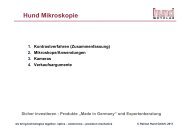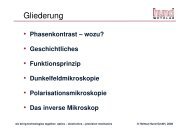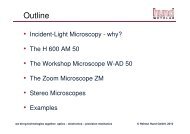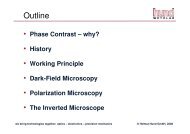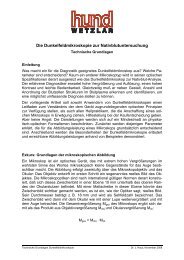The Compound Microscope - Helmut Hund GmbH
The Compound Microscope - Helmut Hund GmbH
The Compound Microscope - Helmut Hund GmbH
Create successful ePaper yourself
Turn your PDF publications into a flip-book with our unique Google optimized e-Paper software.
Outline<br />
• History of Microscopy<br />
• <strong>The</strong> Magnifying Glass<br />
• <strong>The</strong> <strong>Compound</strong> <strong>Microscope</strong><br />
• Brightfield: Köhler Illumination<br />
we bring technologies together. optics – electronics – precision mechanics © <strong>Helmut</strong> <strong>Hund</strong> <strong>GmbH</strong>, 2008
Microscopy<br />
µικροσ µικροσ (mikros): small<br />
σκοπειν σκοπειν (skopein): to observe<br />
we bring technologies together. optics – electronics – precision mechanics © <strong>Helmut</strong> <strong>Hund</strong> <strong>GmbH</strong>, 2008
History of Microscopy<br />
• Well…:<br />
< 10000 BC<br />
we bring technologies together. optics – electronics – precision mechanics © <strong>Helmut</strong> <strong>Hund</strong> <strong>GmbH</strong>, 2008
History of Microscopy<br />
• Zacharias Janssen (1580 – 1638):<br />
First <strong>Compound</strong> <strong>Microscope</strong> (1595)<br />
we bring technologies together. optics – electronics – precision mechanics © <strong>Helmut</strong> <strong>Hund</strong> <strong>GmbH</strong>, 2008
History of Microscopy<br />
• Cornelis Jacobszoon Drebbel (1572 – 1633):<br />
1605: Experiments with lenses,<br />
magnifications<br />
• Robert Hooke (1635 - 1703):<br />
First two-lens light microscope,<br />
book “Micrographia”, 1655<br />
we bring technologies together. optics – electronics – precision mechanics © <strong>Helmut</strong> <strong>Hund</strong> <strong>GmbH</strong>, 2008
History of Microscopy<br />
• Antoni van Leeuwenhoek (1632 – 1723):<br />
High-quality lenses,<br />
270-fold magnification,<br />
staining of specimens<br />
we bring technologies together. optics – electronics – precision mechanics © <strong>Helmut</strong> <strong>Hund</strong> <strong>GmbH</strong>, 2008
History of Microscopy<br />
• Étienne-Louis Malus (1755 – 1812):<br />
Examined refraction of light and<br />
polarization<br />
• George Gabriel Stokes (1819 - 1903):<br />
Discovered light fluorescence,<br />
examined absorption of light<br />
we bring technologies together. optics – electronics – precision mechanics © <strong>Helmut</strong> <strong>Hund</strong> <strong>GmbH</strong>, 2008
History of Microscopy<br />
• Ernst Abbe (1840 – 1905):<br />
1866: Cooperation with Carl Zeiss,<br />
1870: Formula for optical resolving power,<br />
1889: Carl Zeiss foundation<br />
∆x<br />
=<br />
NA<br />
Objective<br />
NA<br />
λ<br />
+<br />
Condenser<br />
we bring technologies together. optics – electronics – precision mechanics © <strong>Helmut</strong> <strong>Hund</strong> <strong>GmbH</strong>, 2008
History of Microscopy<br />
• Paul Ehrlich (1854 – 1915):<br />
Developed staining techniques<br />
for immunology further<br />
• Hans Christian Gram (1853 - 1938):<br />
Gram staining of bacteria<br />
we bring technologies together. optics – electronics – precision mechanics © <strong>Helmut</strong> <strong>Hund</strong> <strong>GmbH</strong>, 2008
History of Microscopy<br />
• August Köhler (1866 – 1948):<br />
1893: PhD degree at University of Gießen,<br />
1894: Köhler illumination,<br />
1900: Started at Carl Zeiss<br />
we bring technologies together. optics – electronics – precision mechanics © <strong>Helmut</strong> <strong>Hund</strong> <strong>GmbH</strong>, 2008
History of Microscopy<br />
• Frits Zernike (1888 – 1966):<br />
1930: Invents phase-contrast microscopy,<br />
1941: Industrialization (German Wehrmacht),<br />
1953: Nobel Prize for Physics<br />
we bring technologies together. optics – electronics – precision mechanics © <strong>Helmut</strong> <strong>Hund</strong> <strong>GmbH</strong>, 2008
History of Microscopy<br />
• Marvin Minsky (1927 – ):<br />
1955: Confocal Laser Scanning <strong>Microscope</strong>,<br />
1956: Coined term “Artificial Intelligence”<br />
we bring technologies together. optics – electronics – precision mechanics © <strong>Helmut</strong> <strong>Hund</strong> <strong>GmbH</strong>, 2008
History of Microscopy<br />
• Stefan W. Hell (1962 – ):<br />
2000: First published the STED microscope,<br />
2002: MPI Biophys. Chemistry, Göttingen<br />
2006: German Future Award<br />
Leica TCS STED<br />
we bring technologies together. optics – electronics – precision mechanics © <strong>Helmut</strong> <strong>Hund</strong> <strong>GmbH</strong>, 2008
<strong>The</strong> Magnifying Glass<br />
mm<br />
M<br />
f<br />
250<br />
=<br />
M ≤ 3<br />
we bring technologies together. optics – electronics – precision mechanics © <strong>Helmut</strong> <strong>Hund</strong> <strong>GmbH</strong>, 2008
<strong>The</strong> <strong>Compound</strong> <strong>Microscope</strong><br />
Sketch! <strong>Microscope</strong> optics<br />
according to DIN: Distance<br />
mounting face objective –<br />
mounting face eyepiece<br />
= 160 mm<br />
(mechanical tube length)<br />
we bring technologies together. optics – electronics – precision mechanics © <strong>Helmut</strong> <strong>Hund</strong> <strong>GmbH</strong>, 2008
<strong>The</strong> <strong>Compound</strong> <strong>Microscope</strong><br />
• Total magnification:<br />
M tot = M obj x M eyepiece<br />
• Example:<br />
Objective 100x, eyepiece 10x:<br />
M tot = 1000x<br />
we bring technologies together. optics – electronics – precision mechanics © <strong>Helmut</strong> <strong>Hund</strong> <strong>GmbH</strong>, 2008
<strong>The</strong> <strong>Compound</strong> <strong>Microscope</strong><br />
Numerical aperture (NA) of an objective<br />
NA = n · sinα<br />
we bring technologies together. optics – electronics – precision mechanics © <strong>Helmut</strong> <strong>Hund</strong> <strong>GmbH</strong>, 2008
<strong>The</strong> <strong>Compound</strong> <strong>Microscope</strong><br />
Numerical aperture (NA) of an objective:<br />
• “Useful magnification”:<br />
M useful<br />
M Museful, max = 1250<br />
= (500 … 1000) x NA<br />
• Resolving power (Abbe):<br />
∆x<br />
=<br />
NA<br />
Objective<br />
NA<br />
λ<br />
+<br />
Condenser<br />
we bring technologies together. optics – electronics – precision mechanics © <strong>Helmut</strong> <strong>Hund</strong> <strong>GmbH</strong>, 2008
<strong>The</strong> <strong>Compound</strong> <strong>Microscope</strong><br />
Magnification > Useful Magnif.?<br />
→ “Empty” Magnification<br />
we bring technologies together. optics – electronics – precision mechanics © <strong>Helmut</strong> <strong>Hund</strong> <strong>GmbH</strong>, 2008
<strong>The</strong> <strong>Compound</strong> <strong>Microscope</strong><br />
Objective markings (DIN 58878)<br />
we bring technologies together. optics – electronics – precision mechanics © <strong>Helmut</strong> <strong>Hund</strong> <strong>GmbH</strong>, 2008
<strong>The</strong> <strong>Compound</strong> <strong>Microscope</strong><br />
Objective markings (DIN 58878)<br />
Infinity-corrected optics:<br />
Parallel rays behind<br />
objectives.<br />
Required:<br />
Tube lens to form the<br />
real intermediate image.<br />
we bring technologies together. optics – electronics – precision mechanics © <strong>Helmut</strong> <strong>Hund</strong> <strong>GmbH</strong>, 2008
<strong>The</strong> <strong>Compound</strong> <strong>Microscope</strong><br />
Objectives: Optical corrections<br />
• Achromats/Apochromats:<br />
Correction of chromatic aberrations<br />
we bring technologies together. optics – electronics – precision mechanics © <strong>Helmut</strong> <strong>Hund</strong> <strong>GmbH</strong>, 2008
<strong>The</strong> <strong>Compound</strong> <strong>Microscope</strong><br />
Objectives: Optical corrections<br />
• (Semi) planachromats: “flat” images<br />
Feld:<br />
18 mm<br />
80 % Feld:<br />
15 mm<br />
60 % Feld:<br />
11 mm<br />
we bring technologies together. optics – electronics – precision mechanics © <strong>Helmut</strong> <strong>Hund</strong> <strong>GmbH</strong>, 2008
<strong>The</strong> <strong>Compound</strong> <strong>Microscope</strong><br />
Illumination: Components<br />
Condenser<br />
Collector<br />
we bring technologies together. optics – electronics – precision mechanics © <strong>Helmut</strong> <strong>Hund</strong> <strong>GmbH</strong>, 2008
<strong>The</strong> <strong>Compound</strong> <strong>Microscope</strong><br />
Illumination: Beam path<br />
<strong>The</strong> collector images the lamp filament onto the<br />
aperture diaphragm.<br />
we bring technologies together. optics – electronics – precision mechanics © <strong>Helmut</strong> <strong>Hund</strong> <strong>GmbH</strong>, 2008
<strong>The</strong> <strong>Compound</strong> <strong>Microscope</strong><br />
Illumination: Beam path<br />
Aperture diaphragm in condenser back focus: Rays from<br />
aperture diaphragm form parallel rays behind condenser.<br />
we bring technologies together. optics – electronics – precision mechanics © <strong>Helmut</strong> <strong>Hund</strong> <strong>GmbH</strong>, 2008
<strong>The</strong> <strong>Compound</strong> <strong>Microscope</strong><br />
Illumination: Beam path<br />
Distance condenser – specimen: field diaphragm gives<br />
sharp image in image plane.<br />
we bring technologies together. optics – electronics – precision mechanics © <strong>Helmut</strong> <strong>Hund</strong> <strong>GmbH</strong>, 2008
Alignment for Köhler Illumination<br />
Image of Field Diaphragm<br />
not<br />
centered<br />
not<br />
centered centered opened<br />
we bring technologies together. optics – electronics – precision mechanics © <strong>Helmut</strong> <strong>Hund</strong> <strong>GmbH</strong>, 2008
Alignment for Köhler Illumination<br />
Köhler Illumination: Effect<br />
we bring technologies together. optics – electronics – precision mechanics © <strong>Helmut</strong> <strong>Hund</strong> <strong>GmbH</strong>, 2008
Alignment for Köhler Illumination<br />
Köhler Illumination: Components<br />
• Field diaphragm<br />
• Height-adjustable condenser<br />
• Aperture diaphragm<br />
“Essential Requirements” in IVDD!!!<br />
we bring technologies together. optics – electronics – precision mechanics © <strong>Helmut</strong> <strong>Hund</strong> <strong>GmbH</strong>, 2008
Alignment for Köhler Illumination<br />
Aperture (Condenser) Diaphragm<br />
• Important for Köhler illumination<br />
• When closed: contrast ↑, resolution ↓<br />
aperture diaphragm<br />
we bring technologies together. optics – electronics – precision mechanics © <strong>Helmut</strong> <strong>Hund</strong> <strong>GmbH</strong>, 2008
Alignment for Köhler Illumination<br />
Aperture (Condenser) Diaphragm<br />
• When closed: contrast ↑, resolution ↓<br />
we bring technologies together. optics – electronics – precision mechanics © <strong>Helmut</strong> <strong>Hund</strong> <strong>GmbH</strong>, 2008




